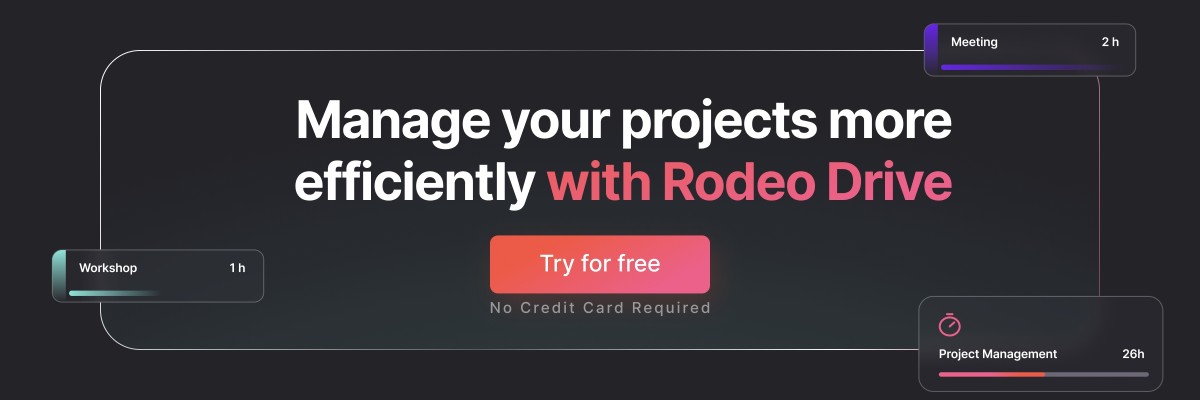How to Track Budgets Using EAC in Project Management
Project planning is an already difficult task that’s made even more challenging when your project faces any sort of uncertainty. Luckily, there are a couple of ways you can calculate your budget’s financial status as circumstances evolve — EAC being one of them.
Estimate at completion (EAC) is a calculation that helps your team better understand how much the project will cost when things don’t go as planned (which, let’s face it, happens a lot).
In this blog, we’ll break down EAC and other relevant project performance measurement terminology, how to calculate choosing the right formulas, and provide some guidance on how a project budget management tool can come in handy. Let’s take a look.
What is EAC in project management?
In project management, EAC stands for Estimate at Completion. This is an earned value management method that project managers can use for forecasting the total cost of their budgets while the project is underway. This way, they can incorporate unexpected obstacles or events that have changed the financial status of the project while still having a projection of what everything will cost overall.
Your EAC calculation will include the amount of time your team has invested up until the point of measurement, along with the remaining costs you expect to incur in bringing the project to completion.
Regularly calculating your EAC is an important part of project cost management, as various project risks can cause your project budget to be either higher or lower than expected.
Understanding the differences between EAC and other cost calculations
Project managers who are skilled in project cost tracking are likely already familiar with several formulas that can be used to gauge the success of your financial management.
If that’s the case, you might be wondering — what’s the difference between all of these measurements? Here’s the rundown:
Estimate at Completion vs. Estimate to Complete
These two terms are deceivingly similar, but it’s important that you’re able to tell them apart. Your estimate at completion will give you an estimate for the total cost of your project, while your estimate to complete only tells you the amount of funding the project still requires.
As such, your EAC calculation will yield a much larger number, since it also accounts for the project costs you’ve already incurred.
Estimate at Completion vs. Budget at Completion
Estimate at completion and budget at completion (BAC) are incredibly similar, with one major difference — the period at which they’re measured. You’ll calculate EAC when your team is already working on the project to see how you can expect your budget to turn out, whereas your BAC is measured before the project begins. Therefore, your BAC is a tidy client-approved estimate of how much the project should cost if everything goes correctly.
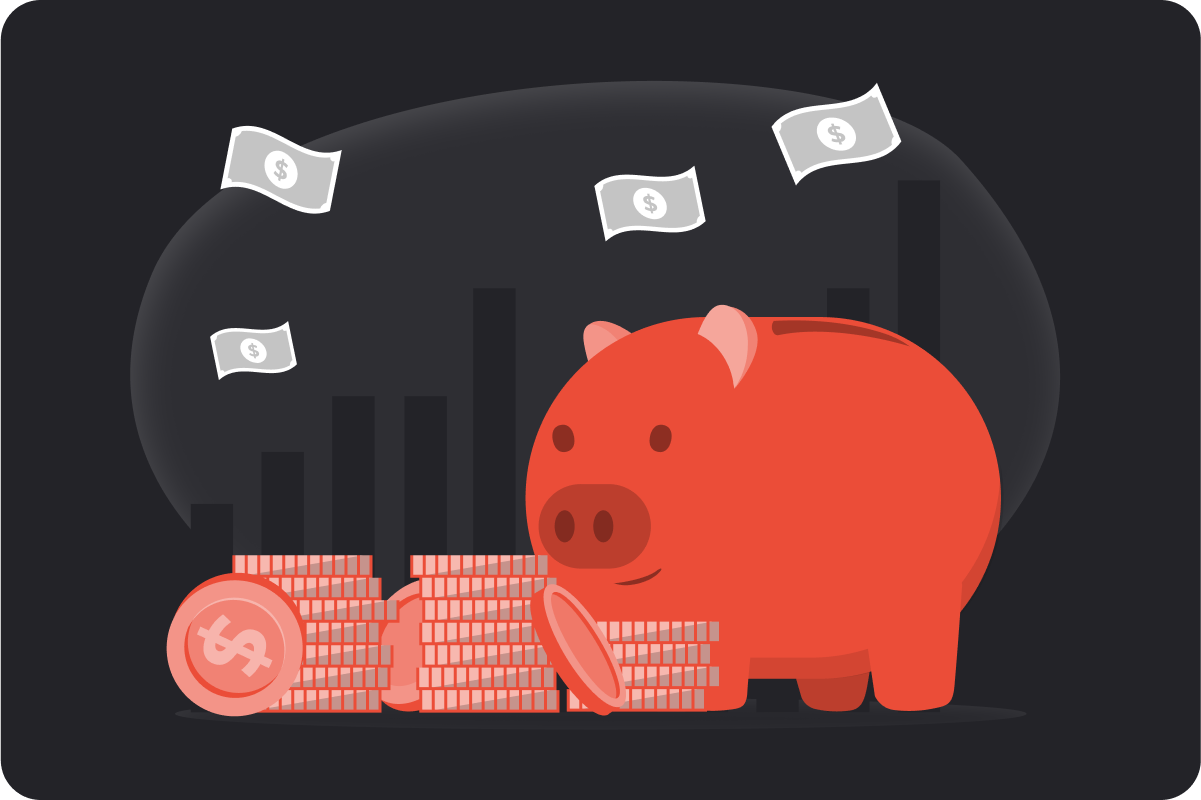
In an ideal world where every project goes according to plan, your EAC and BAC would be the same number. But more often than not, unplanned project costs pop up that can have a significant impact on your estimate. Your EAC helps you better communicate your budget projections to clients and stakeholders.
Related: What Is a Contingency Budget for Project Management?
Estimate at Completion vs. To Complete Performance Index
The to complete performance index (TCPI) is a subset of the cost performance index (CPI), except the TCPI directly looks at how cost-efficient your project must be to complete the final deliverable.
The cost performance index calculates how efficiently your resources are being used in the current period, with a result of less than 1 indicating that changes are necessary in order for the project to be appropriately cost-efficient. The TCPI calculation will then give you a numerical value indicating how severe of an adjustment you need to make.
This is significantly different from EAC, which is focused on total budget cost since TCPI is centered on cost efficiency. You can calculate TCPI using the following formula:

Cheat sheet of terms to know before calculating EAC
To summarize, here are the financial performance terms you should know:
- Estimate at Completion (EAC): A forecast of the total cost of your project at completion based on the money you’ve already spent plus what it will cost to finish the project.
- Estimate to Complete (ETC): The amount of funding required to complete your project going forward.
- Budget at Completion (BAC): The expected total budget for the entire project that was pre-approved before the project started.
- Cost Performance Index (CPI): A cost-efficiency measure of how well you’re using your resources.
- To Complete Performance Index (TCPI): A measure of how drastically you need to adjust in order to make your CPI more cost-efficient.
- Schedule Performance Index (SPI): A measure of how efficiently your team is allocating its time.
- Actual cost (AC): The total cost of your completed project activities up to a certain point.
- Earned value (EV): A measure of the value of the work you’ve performed.
Hopefully, we’ve painted a clearer picture of the differences between the different financial measurements. If not, save the cheat sheet below to help you out before we dive into the formulas.
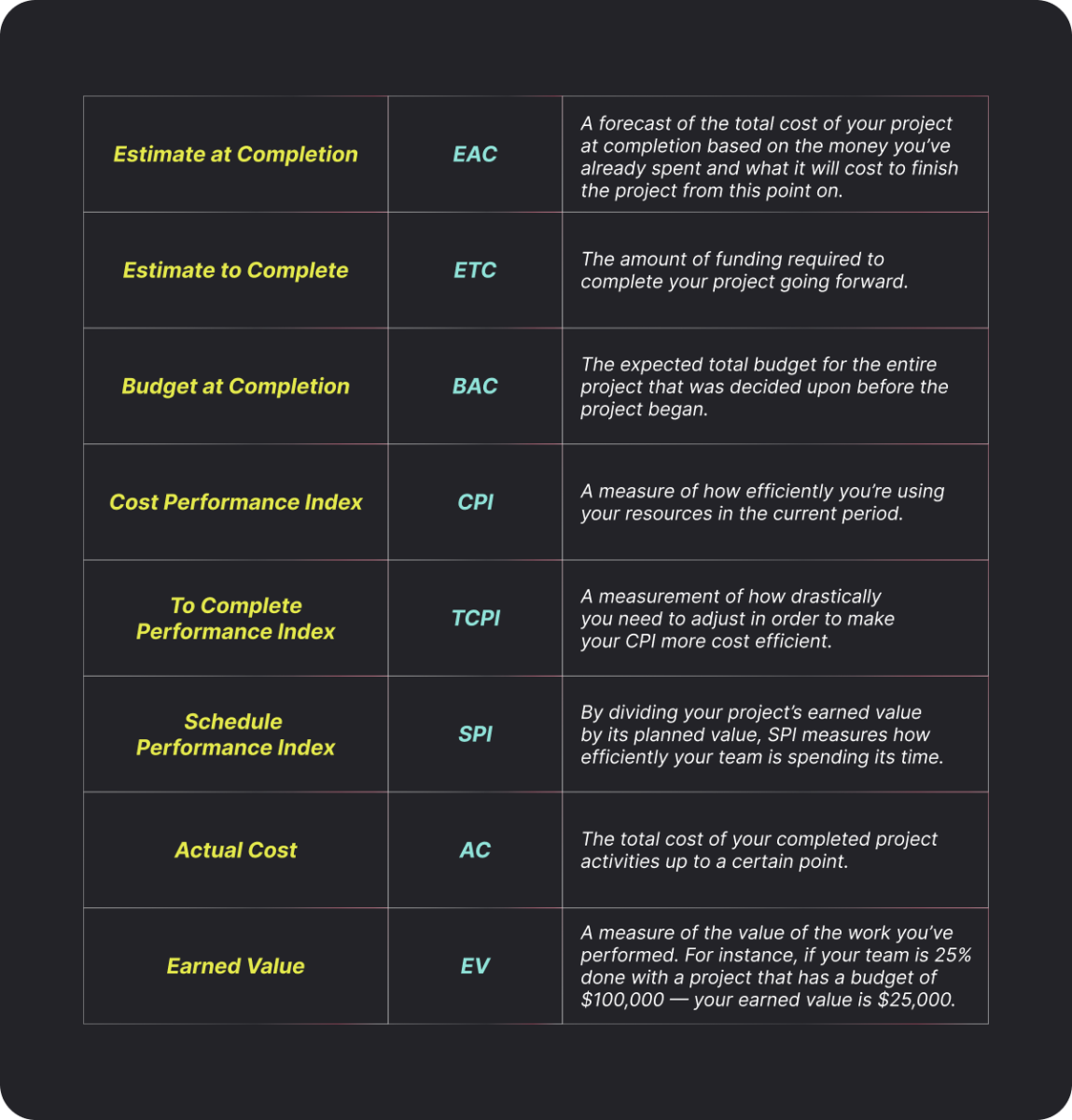
Choosing the right formula to calculate EAC
There are a handful of different formulae that can land you a solid number for an estimate at completion. But which should you pick?
Well, that depends on a variety of factors related to your project status. Under each formula, we’ll explain the typical use case.
EAC = Actual Cost + Estimate to Complete
Adding your actual costs and your estimate to complete is perhaps the most simple way to calculate your estimate at completion, which you’d want to use if your earlier budget forecasts are now irrelevant due to a change in circumstances — or if previous estimates were based on incorrect data.
Recall from earlier that your actual cost is comprised of the amount you’ve spent on project activities thus far (including the cost of your team’s time if you’re charging the client by billable hours) plus the amount you expect to spend on the remainder of the project.

EAC = Actual Cost + (Budget at Completion – Earned Value)
Use this formula to calculate your estimate at completion when your team has encountered and overcome an obstacle and is on track to deliver the rest of the project according to plan.
For example, before starting a project the total budget (budget at completion) was estimated at $100,000. Midway through a project you had to purchase new equipment in order to complete a phase and that wasn’t previously accounted for. You’ve solved the issue and your actual cost — project’s spending so far — is $50,000, and the earned value of the completed work until then is $25,000. Using the EAC = AC + (BAC - EV) your EAC is then $125,000:
50,000 + (100,000 – 25,000) = $125,000
In the above example, you can expect your project to finish at $25,000 over budget since your estimate at completion is now that much higher than your budget at completion.
Related: Navigating Uncertainty: The Importance of a Contingency Plan in Project Management

EAC = Budget at Completion / Cost Performance Index
Let’s say things have generally gone smoothly during your project process. When you run an estimate at completion to double-check that your project budget is on track, you’ll want to divide your budget at completion by your cost performance index, as it’ll illustrate whether you’re cost-efficient enough to deliver on the estimated budget you set before you started working on the project.

Also read: How to Optimize Project Resource Allocation: A Comprehensive Guide
For example, you are halfway through working on a new launch campaign and your budget at completion is $350,000. This project’s cost performance index is 1.10 and you want to make sure the project is still within what you’ve estimated. By applying the EAC = BAC / CPI formula, your EAC is $318,182, which is under your estimated prooject budget:
350,000 / 1.10 = $318,182
EAC = Actual Cost + (Budget at Completion – Earned Value) / Schedule Performance Index * Cost Performance Index
The above estimate at completion formula should be used in circumstances where both your schedule and costs need to be taken into account, which is why SPI and CPI are included in the calculation.
Whenever you’re doing an EAC calculation, you want to be sure that your actual costs are accurate. Failing to track your team’s project expenses can derail your projections and might even impact your strategic plans, especially when you’re relying on a formula this complex.

Related: The Ins and Outs of the Strategic Planning Process
How a budget management tool can help
In order to be able to accurately calculate the right budget metrics, you need a way to properly record and store the relevant project data. The best way to do so is with a project budget management tool like Rodeo Drive.
Rodeo Drive makes it easy to build your project budget according to the resources you’ll need at each project stage. From there, you can send a personalized estimate based on a project budget to a client for approval and invoice them directly from Rodeo Drive once your team begins working.
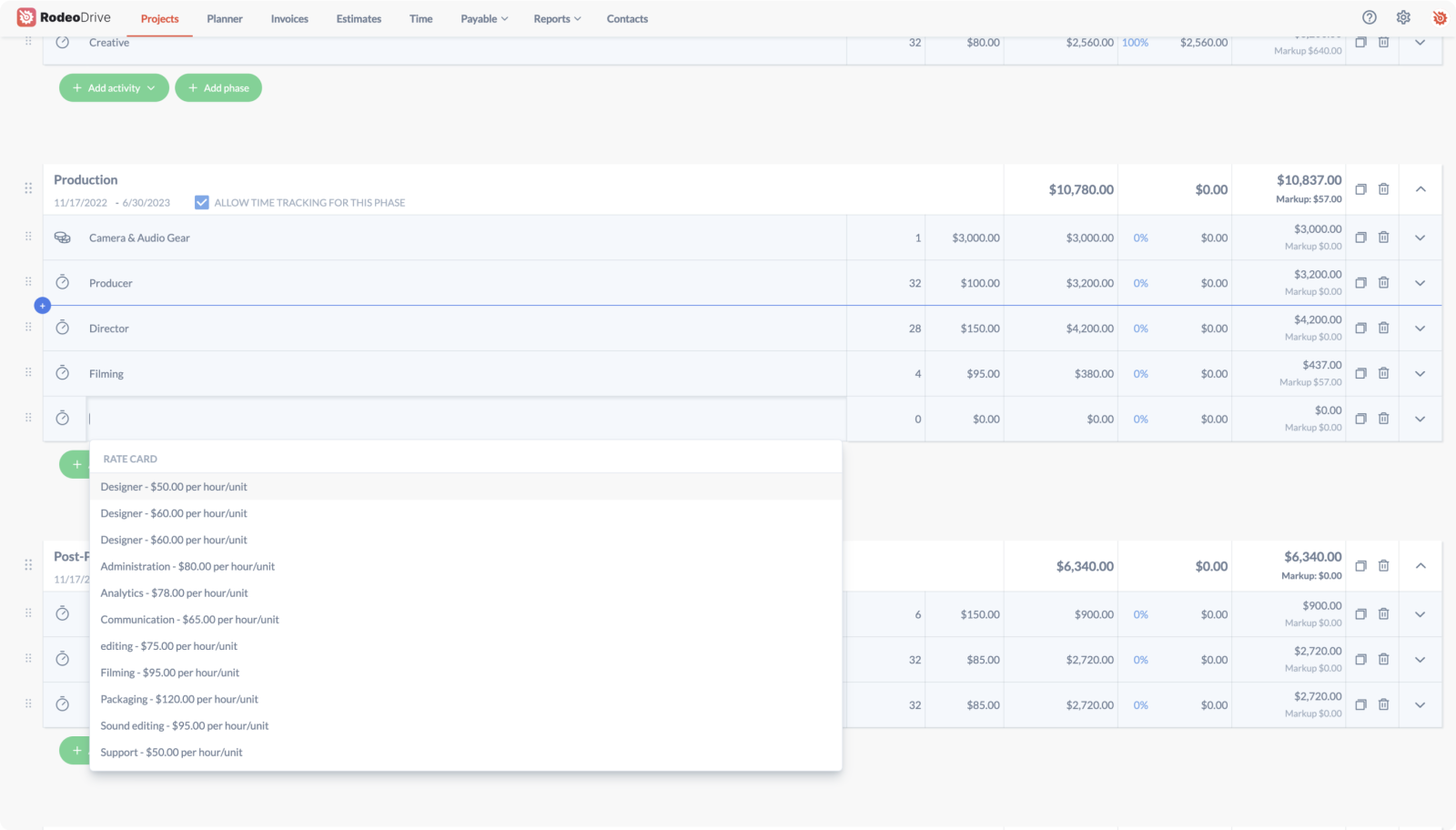
The best part is, Rodeo Drive updates your project budget as you work, which makes it easy to see whether your predicted budget at completion is in misalignment with your estimate at completion.
For example, if a particular project activity takes significantly longer to complete than expected and your team is tracking their time, then you’ll be able to see how that overspend impacts your budget.
Rodeo Drive’s reporting feature will automatically bring you analytics on your project profitability and budget status, which will make it easier to determine when it’s the right time to recalculate your estimate to completion. Plus, having reporting metrics from past projects can provide learnings that increase your likelihood of success for current projects.
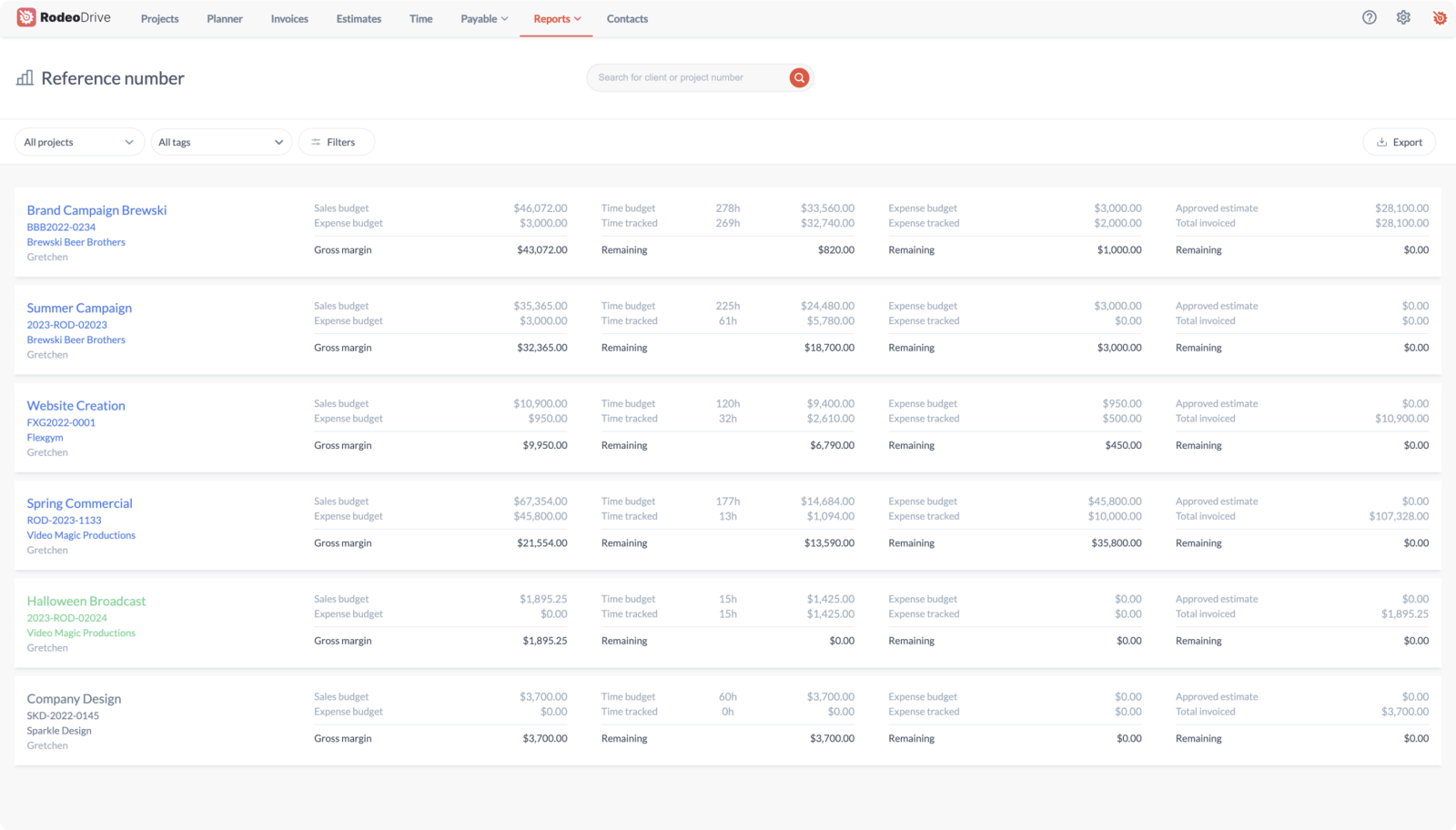
This is the benefit of utilizing an all-in-one project management tool that can do everything in one place. Not to mention, Rodeo Drive is built with the needs of creative teams in mind — allowing you to spend more time creating and less time on financial management.
Interested in learning more about Rodeo Drive? Schedule a demo or sign up for free to try it out.
Takeaway
There you have it — that was our rundown on everything you need to know regarding estimate at completion.
It’s worth noting that whichever EAC formula you end up following, most of them require your BAC calculation to be accurate. Be sure to meticulously calculate your BAC before your team starts working on the project in order to prevent an inaccurate EAC calculation later on.
We know that these metrics on a project’s performance can be a bit technical, which is why you might want to consider adopting a project management software tool. Platforms like Rodeo Drive make it easier to visualize your budget status, serving as a useful resource for those who are less sure of how often EAC should be calculated.
Try out Rodeo Drive for free and see if the platform can help you manage your projects more effectively.






